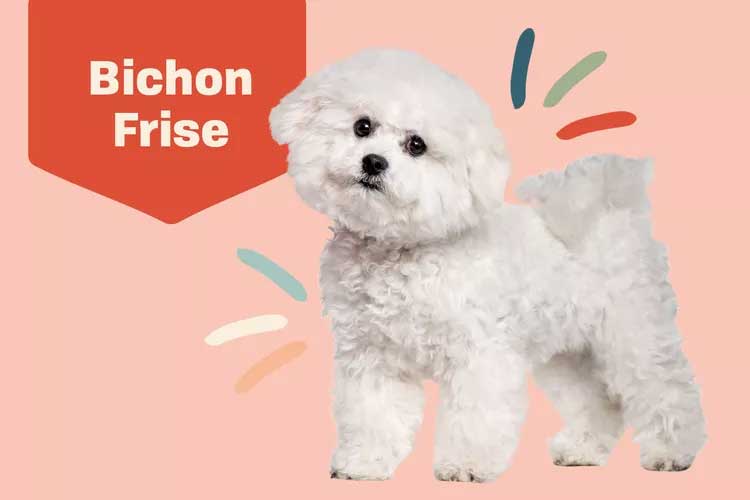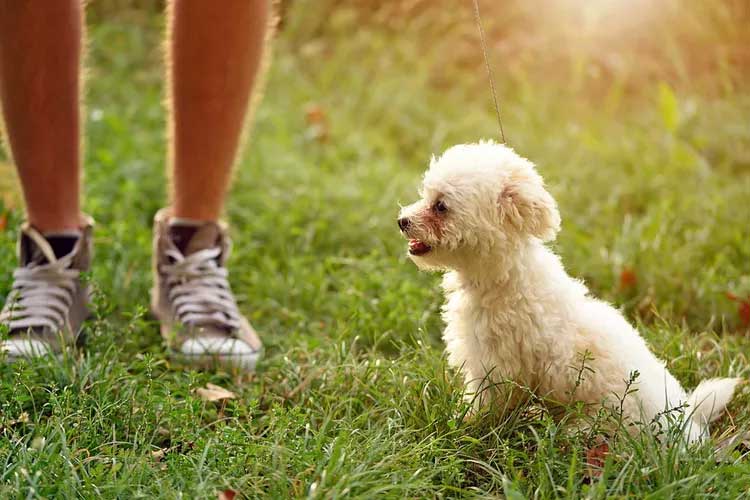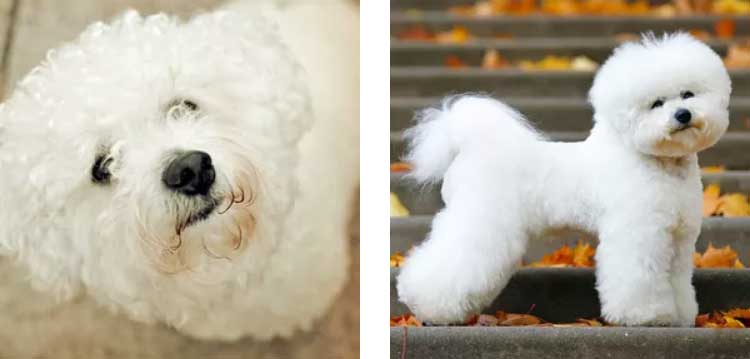Intelligent, affectionate, and incredibly cute, the bichon frise could easily be mistaken for a child’s toy. This happy-go-lucky breed originated in the Mediterranean islands, which could be why they’re so easygoing and fun-loving. Bichons are the perfect companion for families, elderly couples, and everyone in between.

Bichon Frise Overview
| OFFICIAL NAME | Bichon Frise |
| COMMON NAME | Bichon Frise |
| PET HEIGHT | 9 to 11 inches |
| PET WEIGHT | 12 to 18 pounds |
| LIFESPAN | 14 to 15 years |
| GOOD WITH | cats, children, dogs, families, seniors |
| TEMPERAMENT | friendly, outgoing, playful |
| INTELLIGENCE | high |
| SHEDDING AMOUNT | infrequent |
| EXERCISE NEEDS | medium |
| ENERGY LEVEL | active |
| VOCAL LEVEL | infrequent |
| DROOL AMOUNT | low |
| BREED GROUP | non-sporting |
| BREED SIZE | small (0-25 lbs.) |
| COAT LENGTH | curly, short |
| COLORS | cream, white |
| PATTERNS | bicolor |
| OTHER TRAITS | apartment-friendly, easy to train, good for first-time pet owners, hypoallergenic, requires lots of grooming |
The bichon frise (say it with us: BEE-shon Free-ZAY) is just as beautiful as their regal-sounding French name suggests. This Snow White of dogs is beautiful, dainty, and a good choice for people with allergies. They're intelligent and cunning, learning tricks and making the whole family laugh. And because a bichon won't get bigger than 18 pounds, they thrive in apartments and houses alike.
Debbie Hollan, secretary of the Bichon Frise Club of America, has been breeding and showing bichons for over 35 years. "They are loving and delightful additions to almost anyone's home," Hollan says. They also have a mischievous streak, she adds: "They will keep you on your toes."
Appearance
Take one look at a purebred bichon frise and you'll fall in love, instantly. Bichons can be anywhere from 12–18 pounds and stand between 9.5–11.5 inches tall. Their coat is always white, their eyes and noses black.
While there is actually no such thing as a hypoallergenic dog, the low-shedding coat and drool-free tendencies of a bichon frise might make her a good fit for those who tend to sniffle and sneeze around pups.
But take note: Even though she's low-shedding, her double coat can be high maintenance when it comes to grooming. The outer coat stands away from the body, giving her that signature cotton ball appearance.
Temperament
"What is not to love about this silly, friendly, sociable breed?" says Sarah Hodges, author, trainer, and applied behaviorist with the International Association of Animal Behavior Consultants. "Bred to be performers, their chief goal is to make people happy."
Bichon frises love to please, and will impress their owners with their quick ability to learn; it's not surprising that bichons frequent dog shows. The breed has an attitude as soft and snuggly as her fur—she loves to play and snuggle up with her humans. Bichons also get along well with cats and other dogs, as long as they're still getting ample attention from you, her adoring fan.
Living Needs
While bichon frises make excellent apartment dogs because of their size and temperament, they will still need lots of playtime to get their energy out. If they live in a house with a yard, they'll love to run circles outside. They may have little legs, but they can run fairly fast. A fenced-in space is best to ensure a potty break doesn't end in a game of "catch me if you can."
Friendly and easygoing, the bichon enjoys the company of children and other pets. They don't mind a busy house full of people or animals to play with, so they'll fit right in with almost any family. They'll even curl up on a child's lap for a snooze. So long as they're getting enough attention from their humans, they're an easy dog to please.
A bichon frise cannot be left alone often, if at all. They absolutely hate being without their humans. Bichons commonly suffer from separation anxiety if they're left to their own devices, so potential owners need to prepare for a full-time responsibility. "Ignored or isolated, they will go crazy with loneliness and confusion," Hodges says. "They can be over-demanding for affection." A bichon frise needs a doting family who will give her plenty of affection, and she'll give all her love in return.
Care
The characteristic poofy white coat of a bichon won't remain gorgeous all on its own. Expect frequent brushing, bathing, and trips to a professional groomer.
If a bichon isn't brushed a few times a week (at least!), her hair will form mats, which can lead to painful skin issues. Along with the at-home brushing, bichons frises need to see the groomer every four to six weeks for a bath, haircut, and nail trimmings. You'll also need to brush their teeth two to three times a week. Daily oral care will protect them even more from dental diseases.
Bichons have a high energy level but only need a moderate amount of exercise. Romping in the yard or playing with toys a couple of times a day will be enough to satisfy them. They also enjoy participating in competitions such as obedience trials or agility courses to show off their brilliant minds.
One of the best ways to bond with a bichon frise is through training. The breed is highly capable of learning tricks and commands, and they're no stranger to dog shows. While the bichon can be very receptive to learning, they are also slightly cunning. "[They think] they are smarter that you are," Hollan says. "Since they are so smart, you have to be very diligent in your training." Bichons will take scolding to heart, so always use positive reinforcement to incentivize learning. A firm yet gentle hand is required to train a bichon frise.
Health
For bichons specifically, breeders should provide health clearances from the Orthopedic Foundation for Animals (OFA) for hip dysplasia, elbow dysplasia, hypothyroidism, and von Willebrand's disease, a condition that affects the blood's ability to effectively clot. If the parent pups are completely healthy, a bichon should live for a happy 14–15 years.Bichons need regular dental care to ensure they don't get infections, as smaller dogs are more prone to oral health issues. In addition, the breed should be fed in measurements rather than keeping the food bowl full 24/7. According to Traditions Vet Centers in Leonard, Texas, obesity can be a significant health problem for bichons frises. Further, the combination of dental problems and weight gain can result in heart disease. The best way to prevent any heart issues in bichons is to always keep an eye on their food and their teeth. Bladder infections and allergies are not uncommon for this breed as well, so check with a vet if there are signs of irregular urine or excessive scratching.
History
The bichon frise dates all the way back to the 13th century. Originating from islands in the Mediterranean, the breed is a member of the Barbichon family—little white dogs who have similar features and temperaments. Close cousins to the bichon frise include the Maltese, the Havanese, and the Bolognese. According to the Bichon Frise Club of America, historians believe the bichon was introduced to Europe by sailors who brought them back from the islands. With her regal look, the bichon frise quickly found popularity with European nobility. It's rumored that King Henry III had a special basket made to carry his bichons with him everywhere he went.
Decades passed, and the bichon frise got used to the good life. That is, until the French Revolution in the late 1700s, when the nobles (and thus, the bichons) lost their positions of power and privilege. If it weren't for their incredible intelligence, the bichon frise may have gone extinct. Instead, they found a new home in showbiz, showing off their tricks with street performers and circus acts. It wasn't until after the world wars that an official breed standard was adopted and French breeders worked to preserve bichons. They named them bichon a poil frisé, which translates to "bichon of the curly hair." Later, the name was shortened to bichon frise. The little white pups were brought to the U.S. in the 1950s, and these little fluff balls were officially recognized by the AKC in 1972.
Fun Facts
Tori, a bichon frise living in South Korea, has more than 300,000 followers on Instagram—as well as her own wardrobe and miniature Mercedes Benz convertible.The renowned Spanish painter Francisco Goya featured many bichons in his pieces during the 18th century. The most famous is titled "The White Duchess."